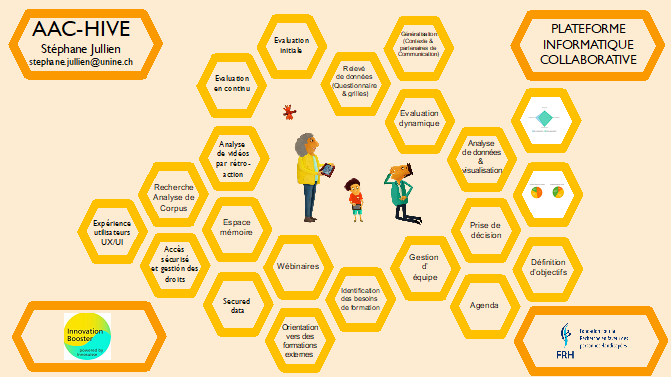Platform AAC-Hive
Phase 2
Type of project: Exploratory research
Disability concerned: Autism and Pervasive Developmental Disorders, Mental disability, Polydisability, Communication disability
Topics: Autonomy, Education, Social participation, Sharing practices
Status: Completed
AAC HIVE is a collaborative IT platform that enables the various communication partners of people with communication disabilities to share their observations, benefit from support to adjust appropriately to the person’s way of communicating and coordinate with professionals to stimulate the development of their communication.
Communication and language disorders can lead to a communication disability, where disability is understood as the interaction between the characteristics of the person and their environment. Adjusting communication partners and deploying resources to make communication accessible in the person’s context (gestures, pictograms, etc.) can limit this disability. Recommendations include working with communication partners on the person’s communication in a social, intensive and immersive way.
The decision-making process for the choice of means, objectives and methods is based on the person’s characteristics and environmental factors. Assessment focuses on both the nature and intensity of the disorder and the effect of the disorder in the social context. There are no clear recommendations for assessment in Alternative and Augmentative Communication (AAC). The gap with the typical development of people with communication disabilities limits the use of standardised tests. Possible sensory impairments, cognitive deficits, challenging behaviours or restricted interests hinder the use of standardised assessment tools.
Evaluation grids, completed by communication partners, provide information about the person’s communication in their social context. However, these grids can lead to the person’s skills being over- or under-assessed. Direct observation and analysis of recordings of interactions complement the observation grids. The platform makes it possible to cover these different needs.
The project provided an opportunity to experiment with team management, involving a company specialising in secure IT platforms and speech and language therapy master’s students working on the platform’s content, with the support of the university partners.
The clinical experience gained and the discrepancy described in the literature between AAC practices in the field and recommendations based on Evidence-Based research were the trigger for this work. The first drafts of the platform were then evaluated in focus groups of families and professionals, including speech therapists, occupational therapists and special educators.
The conclusions of these focus groups led to changes in the platform’s ergonomics and content. This iterative and cyclical process involved building a common culture in order to understand the issues at stake for the various participants.
Focus groups will be organised during the deployment in an institution for adults with intellectual development disorders. Masters in speech therapy are developing the part relating to support for these people’s communication partners. This support is based on AAC-specific methods published in other countries, such as ComAlong in Sweden, or non-specific methods, such as PACT. Decisions about the objectives of this support are based on the observations collected on the platform. Short modelling videos are made available as and when required. Videos of everyday interactions uploaded to the platform are used for video feedback approaches.

